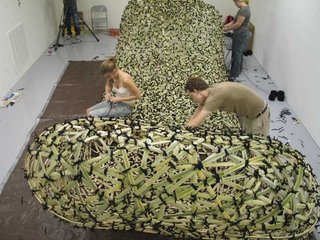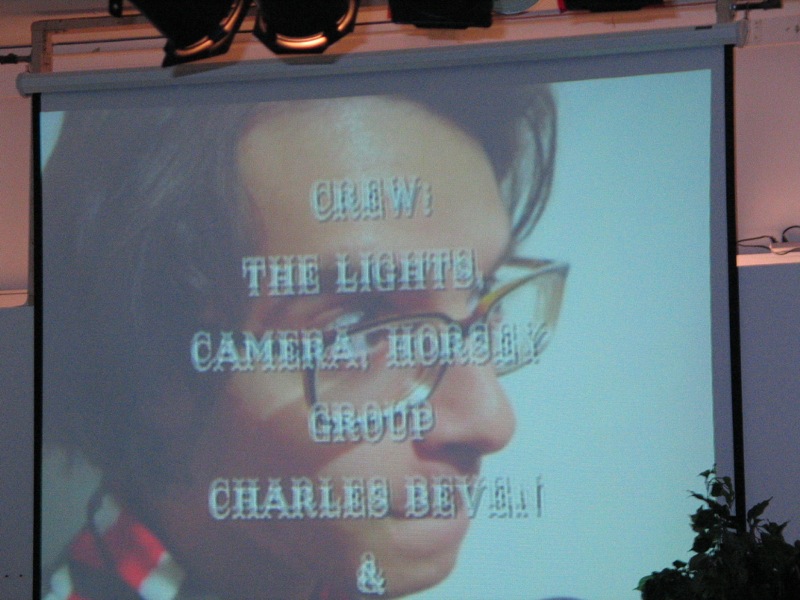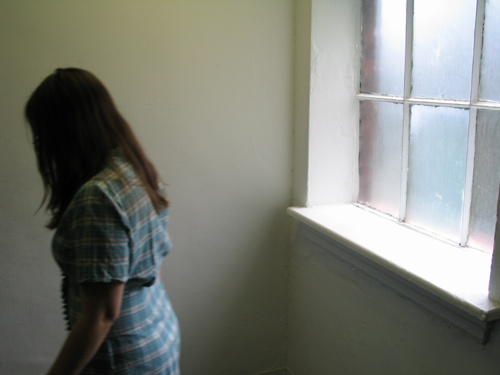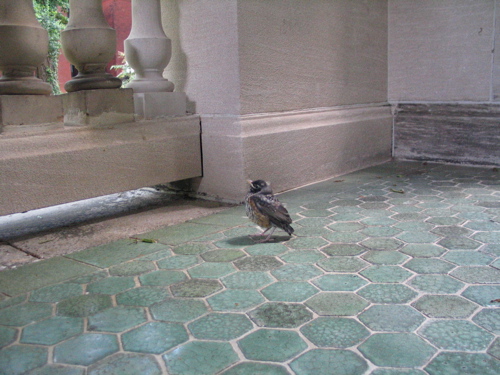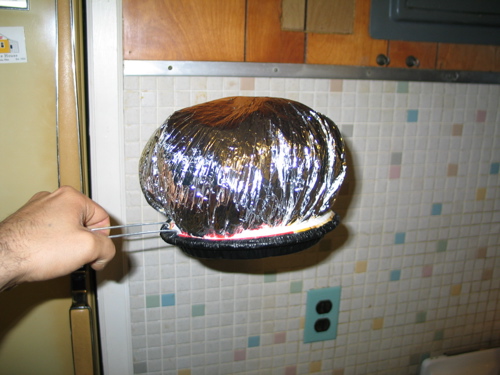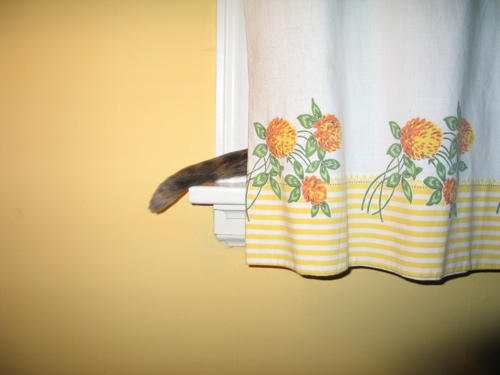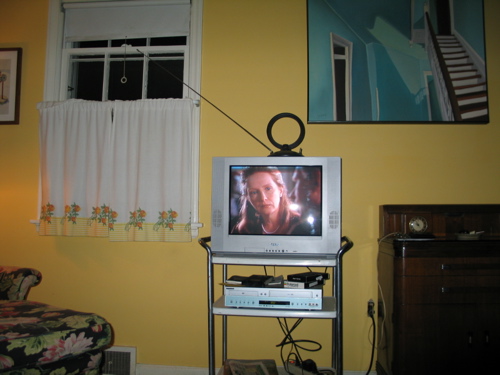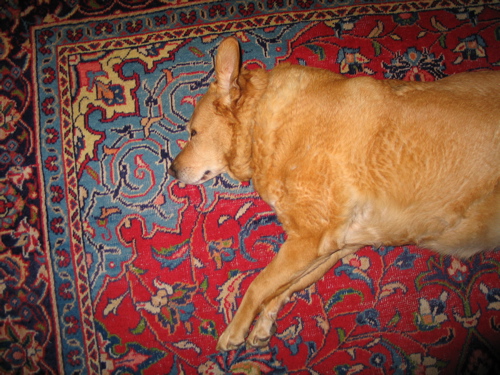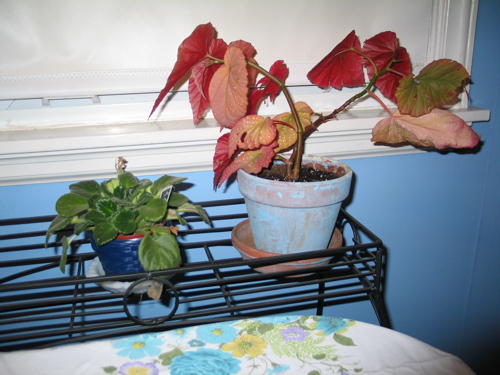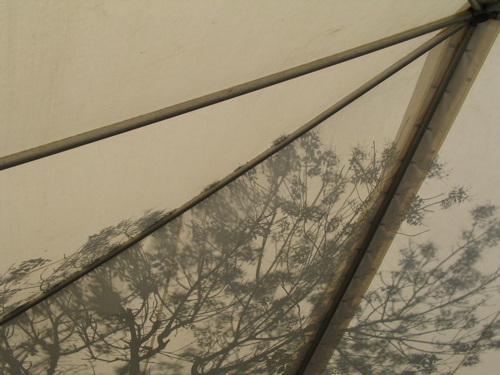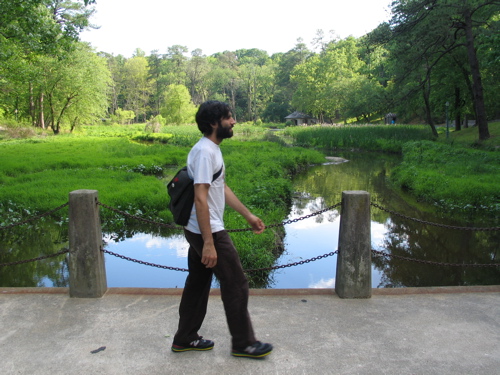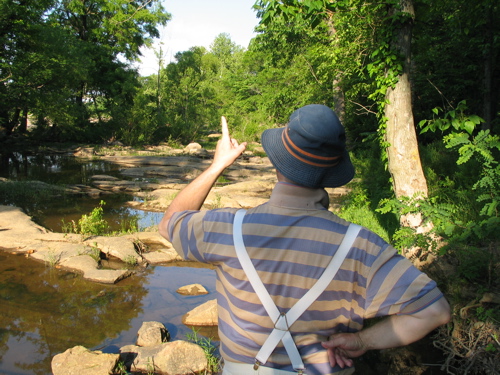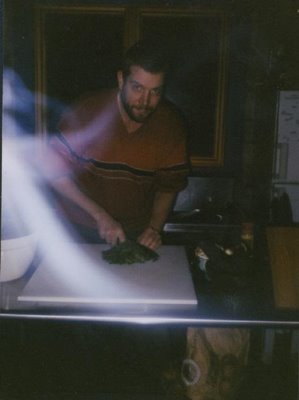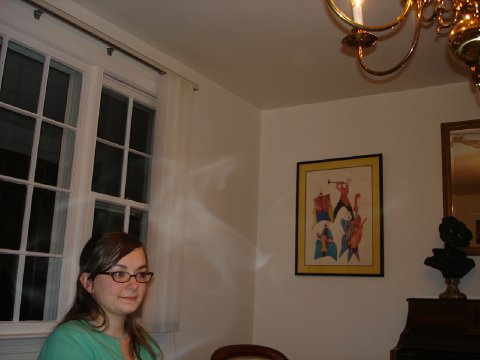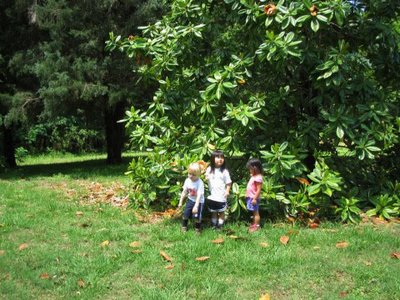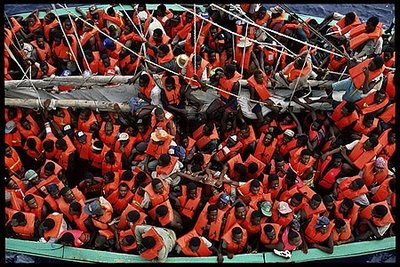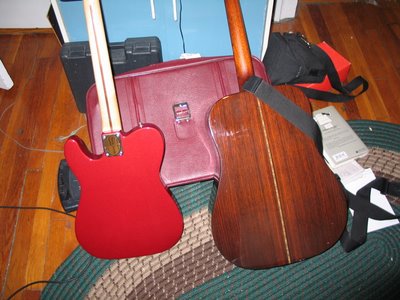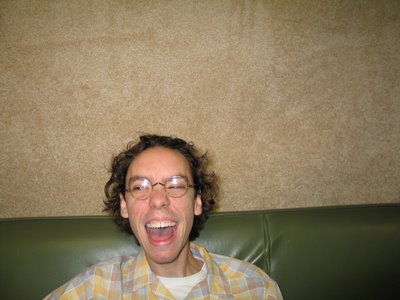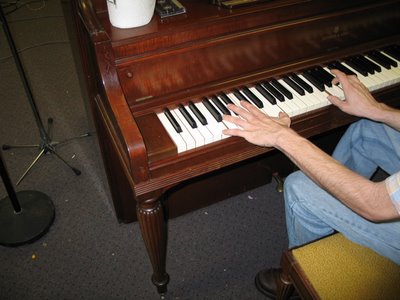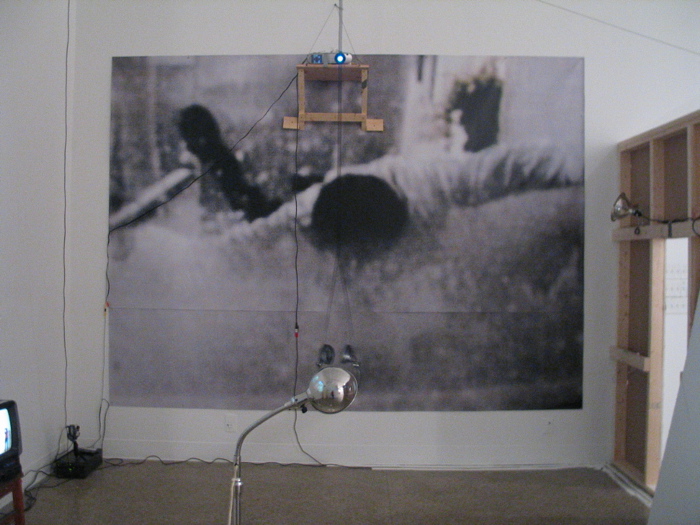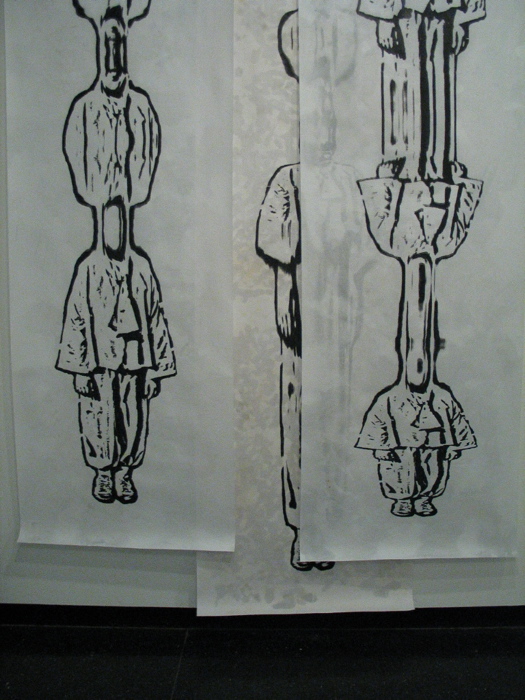My decision to post all of these words marks a turning point in my writing about art on this blog. The arrival of this season’s graduate thesis shows at VCU, and the sudden, wonderful appearance of photo/time based work has made me question whether I want my talk of art on this space to be that posted by a reviewer or a critic. I’m choosing the latter- there are plenty of reviewers (of all things) in the blogosphere, in the newspapers, on TV, and in our daily exchanges. There aren’t enough critics.
Because there are so many words I am going to post serially- two artists today, two more tomorrow...
“The eyes are organs of asking” – Paul ValéryRound One of VCU’s graduate thesis show leaves me, in large part wanting for more. Specifically, the majority of the work leaves me wanting for work made by artists whose urge to communicate reaches beyond the closed doors of their graduate classes, personal websites, need for self expression, or their want of commercial success. I am plagiarizing (though paraphrasing)
AD Coleman when I write that to be a an artist (Coleman differentiates between professional and amateur artist but I am talking about professional artists when I write artist) connotes a sincere wish to communicate (and with the VCU work in mind, I give the students the benefit of the doubt, as so far all of these people are professional students, not professional artists, but I assume that they will all embark on a career of art making beyond their experiences in Graduate school, and so I give them the benefit of the doubt) with the community of viewers that consume the work. So, when I walk into the Anderson Gallery I am looking to have some sort of dialogue with the work in front of me. It is too infrequent that this happens. I imagine that there are plenty of conversations had around the work on view but I would venture to say the words being exchanged are largely those of such a small demographic, and that the conversation couldn’t possibly be made public without each persons’ participation in a couple of years of graduate school, a subscription to Artforum, and a big bowl of Duchamp soup.
With that out of the way, I’m going to limit my critique to the photo, and time-based work made by the graduate students of Photo/Film. They are a barely noticed group (I was one of them so any familiarity you may sense is justified and potentially debateable), and they are illustrative of not only current trends in art making but of art making as it applies to the current climate of photography being accepted (read: sold) by the “Art World”. It is not an accident that of all of the work I write about here, none of the pieces resemble “fine art” photographs. Interesting too, these artists have had, as professors the likes of
Gary Schneider,
Lynne Cohen,
Elizabeth Subrin, and
Chris Sperandio.
Robbie Land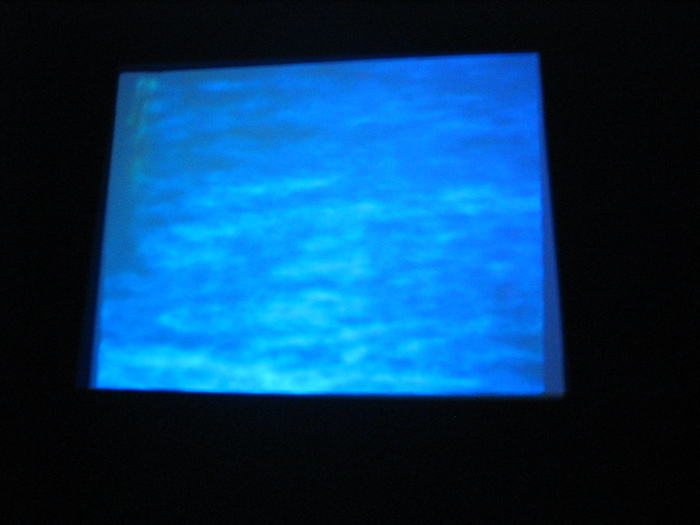 Robbie Land
Robbie Land’s video (16mm color film transferred to DVD)
New Berlin, occupied a small room on the mezzanine, next to the bathrooms. During my first visit I was primarily interested in thinking about Land’s decision to show in such an intimate space- his having painted the room black, the chairs chosen (only two), and the six speakers that filled the room- 4 fairly new, two from a home stereo system (simulated wood grain with patterned mesh grill) allows for the viewer to be completely immersed (or plunged as it may be) into the world of his film. Land uses the familiar space of the movie theatre to his advantage- everyone knows what to do in this space and of all of the artists featured in this show, Land is the only one that demands (and placed his work in such a context to be able to do so) this type of attention.
New Berlin, (named after the location where Land filmed), is a poetic, painterly mash-up of sound and imagery- it’s murky, handheld, cool-toned 16mm fare, edited in a loosely narrative sequence that seems to be concerned with (if anything other than looking good) the efforts of navigation.
New Berlin clocks in at a short, and sweet 3-4 minutes. All filmmakers should take a cue from pop musicians and not make videos that are longer than the average pop song.
New Berlin is filmed in first person and Land takes the viewer on a journey from beneath, to above and back to below a waters surface. There are boots being lapped at by water on a pier, close-ups of a compass (presumably on one of the ships that are shown), and near the end, the camera dives into the water a couple of times (first into a reedy patch of shallow water, and then into a gorgeous school of goldfish swimming to the soundtrack of a bullhorn) before succumbing completely to being under water and watching as a jellyfish (not know for their speed) swims by. Like all of Land’s films, audio is paramount in
New Berlin and it fuses together the sometimes-disparate images with the rhythmic flicker of the projected film. Presumably, the audio tracks (maybe 4?) are culled from New Berlin (the place) as well, but it could easily be that many of them were not. I’m not sure it matters. The audio has the sound (and when paired with the imagery, the appearance) of someone poring over hours of audio and picking out (and refining) the phrases best suited for the collected images.
Metaphorically, Land’s concerns are pretty clear- life, as well as the making of a film is a series of struggles with (and within) the self, as well as with the world outside of the self, and this film points to how we all try to learn how to use the tools given to us to figure out how to make our way through this mess. That is a tried and true impetus for art making but there needs to be more. The problems with
New Berlin aren’t the images and it’s not the audio. It’s the decision to pair the two together. I believe Land is a musician skilled at crafting lugubrious soundtracks out of found sounds – he’s a filmmaker skilled at weaving rhythmic pastiches of romantic, abstract expressionist, DIY,
Brakage-ish, cutting-room-floor stuff that hipster cred is made of. What’s the problem then? The problem is that the film is all persecution and no resurrection. It’s self conscious indie fare and when I sit down to watch a film I hope to learn that there is another person out there who has figured out a way to make it through this mess and I’m disappointed to find someone content to flail in the murky waters of abstract and expressionist unknowing (this is the same reason I don’t listen to music by bands like Godspeed You! Black Emperor or Blonde Redhead). I’d suggest to Land that he begins collaborating, ask his professor
Sonali Gulati how it felt to have people connect to her and her film at the Black Maria Film Festival or, if nothing else set himself some parameters- like forcing himself to make a film (and accompanying audio track) that clocks in at more than 60 bpm. Then maybe there could be a little balance- a little resurrection with our oftentimes-necessary persecution.
Eileen Rafferty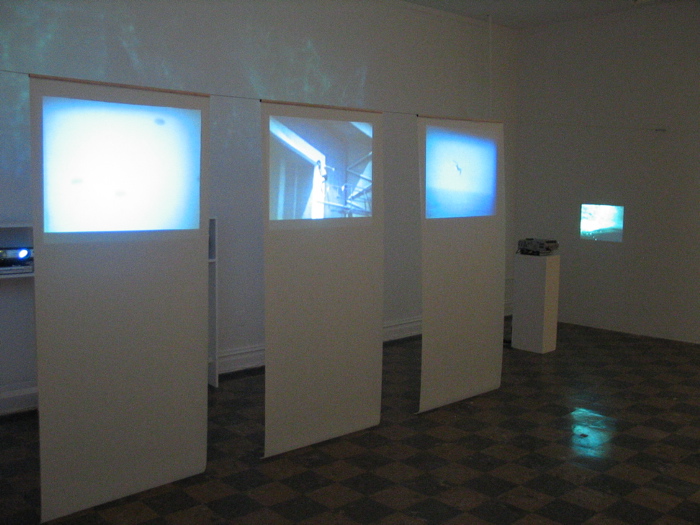
Way up on the 3rd floor, in the northwest corner, in a low ceilinged, square tiled room of the Anderson Gallery was
Eileen Rafferty’s 4-channel video installation
jimmy hit his first home run. For this installation Rafferty employed three long scrolls of white paper attached equidistance apart, to a wire strung between the gallery’s north and south walls as projection screens for three of the videos. The scrolls were coated with a transparent substance (gel medium?) and the video was projected onto them from behind, the gel medium caused the light from the videos to reflect a swimming pool like pattern on the west walls. The imagery was culled from Rafferty’s late father’s 8mm home movies (edited down by Rafferty so that each sequence was no longer than a minute). The fourth projection, shot with a video camera, was projected onto the wall adjacent to the scrolls. This slow, color video of bubbles rising in front of a backdrop of a setting, stormy sun is significantly different hue and image quality from the rest. If the footage on the scrolls could be viewed as the parents’ table, the bubble video is the table set aside for those not mature enough to sit with the adults- it’s next to the parents table, but smaller, lower, and out of the way. This division makes it clear that this is the lesser of the images in the installation. Rafferty does herself a disservice by treating the video this way- the bubbles are so surprisingly meaningful and beautiful that it would have been excellent company, and worked as a good counterbalance for the other videos.
Rafferty’s decision to segregate and thereby create a hierarchy among makes me think that her choice to separate the videos is evidence of the common trap that photographers, and other practitioners who work in series and editions, fall into- the tendency to present only stylistically and conceptually consistent work near one another. Photography loves the stain around the bathtub- the series of images, all the same size, and all printed and mounted in a way so similar that all the viewer needs to do (because oftentimes the imagery is also the same idea beaten to death twenty-plus times) is quickly walk around the gallery, with their nose about 10-12 inches from the glass, make a quick appraisal, and then zoom-- they’re out the door thinking that the image on the postcard was really all that was necessary.
But, despite this segregation of images, Rafferty’s installation transcends this limitation and the images occupy that sad, beautiful and familiar space that
Felix Gonzalez Torres’ images and sculpture occupy. Hers too are archetypical images that already exist within us- most of us have thought about the violence and beauty of the high dive, we’ve all put ourselves in the place of skydivers, which of us hasn’t wanted to fly, and when weren’t we fascinated by the short life of a blown bubble? Life and death surround our every thought, dream and action.
jimmy hit his first home run works beacuse Rafferty knows that in order for us to experience this work and these simple truths, she needn’t worry about giving us much- all she gives us (and it’s just the right amount) is an elegant synthesis of light, material, and close to home imagery that makes the viewing of the installation at once embarrassingly personal and necessarily universal.

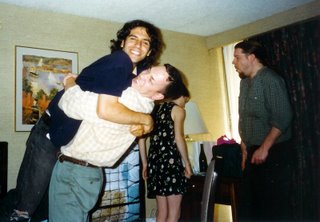 And finally, for good measure, here's a picture of Robin and me from way back in 1996. The pic was taken at a hotel in DC when a group of us went to see/hear Billy Bragg. That's the first time I ever heard Smoke- a band that fits perfectly into the aforemntioned list of the dark and dreary.
And finally, for good measure, here's a picture of Robin and me from way back in 1996. The pic was taken at a hotel in DC when a group of us went to see/hear Billy Bragg. That's the first time I ever heard Smoke- a band that fits perfectly into the aforemntioned list of the dark and dreary.
